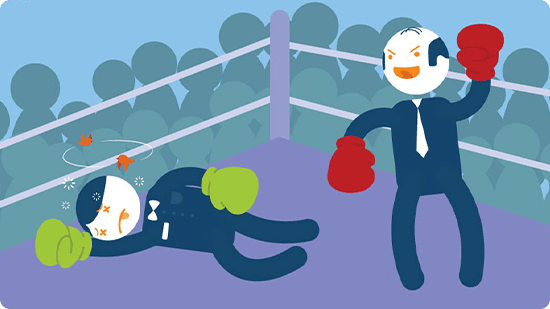When you’re trying to make a point, it’s often beneficial to start off with a quote from a famous person to add a level of credence to said point. So, in my infinite wisdom, that’s what I’ll do. Allow me to quote the immortal words of prolific 20th century poet Eminem:

I was quite young when I first heard Eminem’s “Lose Yourself”. Honestly, I was probably far too young and, somewhat poetically, much of its meaning was lost on me. Its meaning was lost, not because I didn’t understand it, but because I couldn’t relate to it at the time. You see, I was but a mere 10 years old, and I wouldn’t experience that level of performance and social anxiety until a few years down the road. My mother, however, did make a pretty mean Bolognese back in the day.
Now that I’m a little older, I consider myself a confident public speaker—something that wasn’t always the case. Overcoming performance anxiety and becoming a confident public speaker is about preparation and practice. I’d like to share with you my five keys to preparing a presentation, with something that I have just now decided to call – “Four ‘what’s’ and a ‘who’”. Pretty catchy, right?
What’s the goal?
Preparing a solid presentation, like anything in life, requires a little foresight. I’m not talking about psychic powers or anything supernatural, but I am talking about having a vision. What’s the point of your presentation? If you’re anything like I was during my adolescence, you may be thinking: there is no point! What’s the point to anything? Why are we even here? How do I get Emily Stephenson to acknowledge my existence? I wish I was never born!
I’ll spare you my teenage existentialism for a second; let’s focus on what’s important, which, coincidentally, is: what’s important? What do you know that your audience doesn’t? What would you like them to learn by the end of your presentation? Visualising where you want your presentation to end up goes a long way to actually getting there.
Having a clear goal from conception to delivery is paramount to the effectiveness and impact of any presentation.
What’s the subject?
You have your goal. Now it’s time to figure out how you’re going to get there, which brings us to the subject. What is your presentation about? Whether your subject is given to you by an employer, a teacher, or you have the luxury of picking it yourself, you must ensure you really know what you’re talking about.
You may be forgiven for believing this to be the easy part, but I can assure you that pinpointing the key focus of your presentation is no easy feat. Hypothetically speaking, let’s say you’re preparing a presentation on beach balls. Sounds pretty easy, right? But what about beach balls is your presentation going to focus on specifically? Thickness? Bounceability? Why do thousands of people find a floating ball of air more interesting than cricket? Why do thousands of other people find cricket more interesting than a floating ball of air?
Specificity is the key to planning a good presentation. If you lack it, you’ll run the risk of winding up with a disinterested audience.
What’s the timeframe?
Many people speculate that time is a place. I’m no astrophysicist, and I’ve never been all that keen on speculation; however, I’ll tell you one thing I know for certain about time for free: it’s expensive. People, especially in business, value time more than anything else, so when it comes to preparing your presentation, make sure you know exactly how long you need to make your point.
Let’s say you’re preparing a presentation about the health benefits of apples. How much of your time should you allocate to oranges? See what I’m getting at here? Contrary to popular belief you may want to spend some of your time comparing apples to oranges, but only if it supports your initial point and the focus remains on the apples.
When you prepare your presentation, be as brutal an editor as you can be—there’s no time for superfluous information. If it adds something valuable, keep it. If not, cut it.
What’s the environment?
If you’re worried about your upcoming presentation, it would make sense to take steps to alleviate as much of that anxiety as possible. A large part of this comes down to feeling comfortable with the presentation itself. But what about feeling comfortable in the physical space in which you’ll be giving the presentation? It’s the reason weddings have dress rehearsals and bands have sound checks—to increase familiarity and reduce the potential for error.
So what can you do to help familiarise yourself with your presentation environment? In a perfect world, paying a visit to the venue is a great place to start. Make yourself a checklist and allow enough time to take a look around, scope out the facilities and the technology at your disposal. If your presentation relies heavily on an overhead projector, you’d be wise to ensure your venue has one available.
Every little detail within the physical environment of your presentation is crucial, from the size of the room to the lighting. If you want to look confident and comfortable during your presentation, you need to feel confident and comfortable during your presentation. Don’t risk the flow and impact of your presentation by cutting corners. Familiarise yourself with your environment and take home field advantage with you wherever you go.
Who is the audience?

We know the goal, the subject, the timeframe and the environment—looking good. Now it’s time to take a look at the most important element of planning a presentation: the who. Who is your audience? There’s no use giving a presentation about apples at a convention about oranges… You see my point.
Finding out as much information as possible about your prospective audience is a must. What’s the age range? What’s the mix of genders? Are they there under mandatory circumstances or are they there for pleasure?
What works for one audience isn’t guaranteed to work for another. Find out what’s going to work this time, for this specific audience.
Bonus Who
This is a fun surprise, isn’t it? Just when you thought we were done, there’s an added little bonus at the end… an after-dinner mint, of sorts. It’s time for one more “who”, and at the risk of sounding like a Dr. Seuss poem, the who is you!
There’s so much to think about when preparing a presentation, that it’s easy to overlook the star of the show. Don’t let the stress, anxiety and self-doubt that goes along with giving a presentation make you forget what (who) people are really coming to see.
Just because giving a presentation might differ from the norm, don’t stray too far from your daily routine. To ensure you present the best version of yourself, follow these steps:
- Sleep: Don’t show up to your presentation with bags under your eyes bigger than Donald Trump’s ego; aim for bags as small as his IQ.
- Eat: You must do this to live.
- Shower & Deodorise: If your presentation stinks, people will forget. If you stink…
- Believe: Self-belief is a powerful thing. Believe in yourself and your audience will follow.













